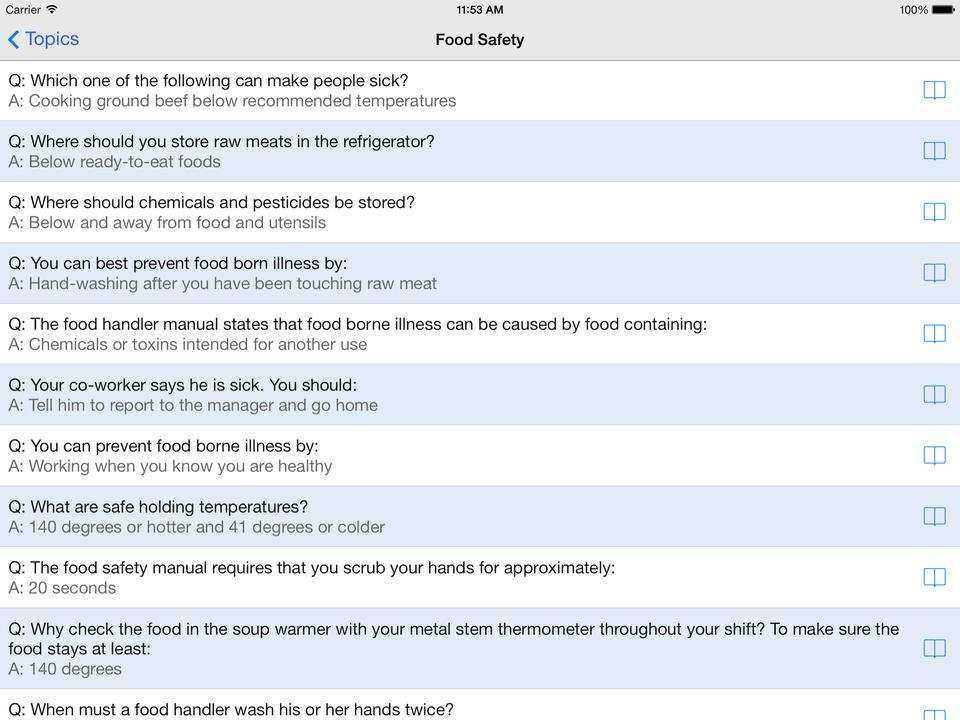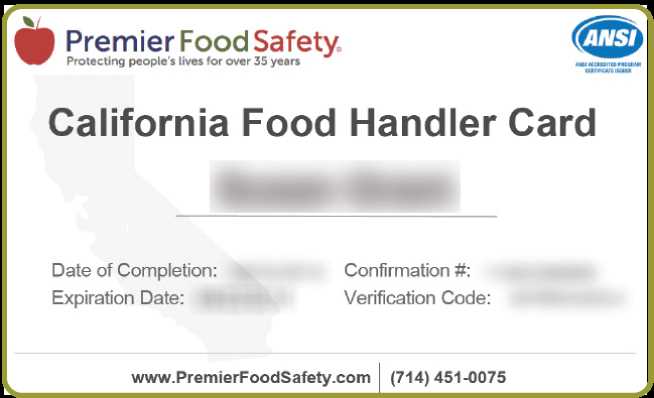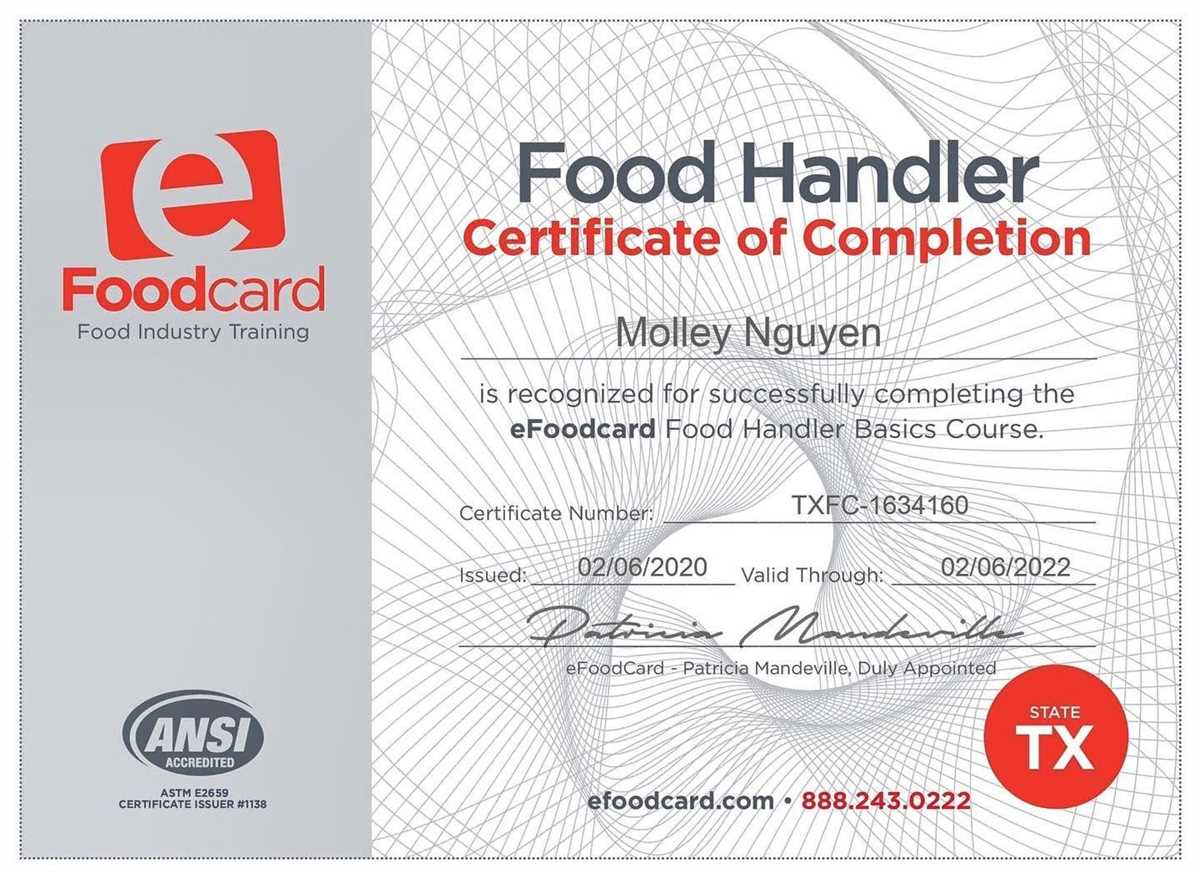
When working in the food industry, it is important to have a thorough understanding of food safety practices. One way to demonstrate this knowledge is by obtaining a food handlers card. However, passing the test to obtain this card can sometimes be challenging. In this article, we will provide you with answers to common questions found on the food handlers card test.
One of the most important areas covered on the test is proper food handling and storage. Questions may ask you about the correct temperature to store perishable food items, such as meat and dairy products. It is essential to know that these types of foods should be stored below 41 degrees Fahrenheit to prevent the growth of harmful bacteria.
Another key topic covered on the test is personal hygiene. Questions may ask about the appropriate handwashing techniques and when it is necessary to wash your hands. Remember, it is crucial to wash your hands before handling food, after using the restroom, and after touching your face or hair. Additionally, wearing clean, disposable gloves is necessary when handling ready-to-eat food items.
Foodborne illness prevention is also a significant component of the test. Questions may inquire about the symptoms of common foodborne illnesses, such as Salmonella or E. coli, and how to prevent them. It is crucial to understand that proper cooking temperatures and avoiding cross-contamination are essential for preventing the spread of these illnesses. Always ensure that food is cooked to the correct internal temperature and that raw and cooked foods are kept separate to avoid cross-contamination.
By familiarizing yourself with these answers and understanding the principles behind them, you will be better prepared to pass the food handlers card test. Remember to study and review the material regularly to ensure that these practices become second nature. By doing so, you will help maintain a safe and healthy environment for both employees and customers in the food industry.
Answers to the Food Handlers Card Test
When taking the food handlers card test, it’s important to know the correct answers to ensure that you are knowledgeable about food safety and handling. Here are some of the answers to common questions that you may encounter on the test:
1. What is the danger zone for food?
The danger zone for food is between 40°F (4°C) and 140°F (60°C). Food should not be left in this temperature range for more than 2 hours, as bacteria can rapidly multiply and cause foodborne illnesses.
2. What is the proper way to wash your hands?

When washing your hands, it is important to use warm water and soap. Scrub your hands for at least 20 seconds, making sure to clean all areas, including between your fingers and under your nails. Rinse thoroughly and dry with a clean towel or air dryer.
3. How should you handle raw meat and poultry?
Raw meat and poultry should be stored separately from other foods to prevent cross-contamination. Use separate cutting boards, utensils, and containers for raw meat to avoid spreading harmful bacteria. Cook these products to a safe internal temperature to eliminate any pathogens.
4. What is the temperature for cooking chicken to ensure it is safe to eat?
Chicken should be cooked to an internal temperature of 165°F (74°C) to ensure it is safe to eat. Use a food thermometer inserted into the thickest part of the chicken to accurately measure the temperature.
5. What are the symptoms of foodborne illness?

Common symptoms of foodborne illness include nausea, vomiting, diarrhea, abdominal pain, and fever. These symptoms can occur within hours or days after consuming contaminated food and can vary depending on the type of pathogen.
6. What is the best way to prevent cross-contamination?

The best way to prevent cross-contamination is to keep raw and cooked foods separate. Use separate cutting boards, utensils, and containers for each type of food to avoid spreading harmful bacteria. Clean and sanitize surfaces between handling different types of foods.
- To summarize, knowing the answers to these food handlers card test questions can help you demonstrate your understanding of food safety and handling. By following proper procedures and guidelines, you can play a vital role in preventing foodborne illnesses and ensuring the safety of the food you handle.
The Importance of the Food Handlers Card

Obtaining a Food Handlers Card is crucial for anyone working in the food industry, as it ensures that employees have the necessary knowledge and skills to handle food safely. The card serves as a certification that individuals have completed a food safety training course and understand the regulations and best practices for food handling and preparation. It demonstrates their commitment to maintaining high standards of food safety and protecting the health and well-being of consumers.
Holding a Food Handlers Card not only benefits the individuals themselves, but also the establishments they work for. Having trained and certified employees reduces the risk of foodborne illnesses and other potential health hazards. By following proper food handling protocols, such as maintaining cleanliness, practicing safe food storage, and preventing cross-contamination, food handlers can protect the integrity and quality of the food they serve. This, in turn, promotes customer satisfaction and confidence in the establishment.
- Compliance with Regulations: Many states and local health departments require food handlers to obtain a card as part of their licensing and inspection processes. By obtaining a Food Handlers Card, employees ensure compliance with these regulations and avoid potential fines or closure of the establishment.
- Professional Development: Completing a food safety training course and obtaining a Food Handlers Card can enhance an individual’s professional development within the food industry. It demonstrates their commitment to their profession and shows potential employers that they have the necessary skills and knowledge to handle food safely.
- Safe Food Handling Practices: The training and certification process for the Food Handlers Card covers important topics such as proper handwashing techniques, temperature control, and prevention of food contamination. By following these practices, food handlers can reduce the risk of foodborne illnesses and ensure the safety of the food they handle.
How to Obtain a Food Handlers Card
Obtaining a food handlers card is an essential requirement for individuals working in the food service industry. This card demonstrates that the holder has received proper training in food safety and hygiene practices, ensuring that they can handle and serve food in a safe and sanitary manner. Here are the steps to obtain a food handlers card:
- Research the requirements: Begin by researching the specific requirements of your state or local jurisdiction regarding food handler certification. Different regions may have different rules and regulations in place.
- Complete a training course: Enroll in and complete a food handlers training course that meets the requirements set forth by your jurisdiction. These courses are usually available online or in-person, and cover topics such as personal hygiene, cross-contamination, proper food storage, and foodborne illnesses.
- Pass the exam: After completing the training course, you will be required to pass an exam to demonstrate your knowledge and understanding of the material. The exam may be taken online or in person, and typically consists of multiple-choice questions.
- Pay the fee: In most cases, there is a fee associated with obtaining a food handlers card. Pay the required fee to complete the process and receive your card.
- Receive your card: Once you have passed the exam and paid the fee, you will be issued a food handlers card. This card should be kept on your person while working in the food service industry and be readily available for inspection by food safety regulators.
It is important to note that food handlers cards are usually valid for a certain period of time, typically one to three years. After this period, you may be required to renew your card by taking a refresher course and passing the exam again. By obtaining and maintaining a food handlers card, you not only ensure compliance with regulations but also contribute to the health and safety of consumers.
Common Questions on the Food Handlers Card Test

Obtaining a food handlers card is an important step in ensuring the safety and hygiene of food service establishments. To pass the test and obtain the card, it is important to have a good understanding of the requirements and procedures. Here are some common questions that individuals may have when preparing for the food handlers card test:
1. What is a food handlers card?
A food handlers card, also known as a food safety certificate or food permit, is a document that certifies that an individual has completed a food safety training course and has demonstrated knowledge of safe food handling practices. It is usually required by law for individuals who work in the food service industry.
2. How can I prepare for the food handlers card test?
To prepare for the food handlers card test, it is important to study the materials provided in the food safety training course. These materials often include information on foodborne illnesses, safe food handling practices, personal hygiene, and proper cleaning and sanitizing procedures. Taking practice tests and reviewing the course materials regularly can also help in familiarizing yourself with the content and format of the test.
3. What topics are covered in the food handlers card test?
The food handlers card test typically covers a wide range of topics related to food safety and handling. Some of the common topics that may be covered include proper handwashing techniques, temperature control, preventing cross-contamination, identifying and reporting foodborne illnesses, and allergen management. It is important to have a good understanding of these topics to pass the test.
4. What is the passing score for the food handlers card test?
The passing score for the food handlers card test may vary depending on the jurisdiction. In most cases, a score of 70% or above is required to pass the test. It is important to check with the local health department or regulatory agency to determine the specific passing score for your area.
5. What happens if I fail the food handlers card test?
If you fail the food handlers card test, you may be required to retake the test. The specific procedures for retaking the test may vary depending on the jurisdiction. It is important to review the materials provided and take additional time to study before retaking the test.
Understanding Food Safety Regulations
Food safety regulations are put in place to ensure the health and safety of consumers. These regulations outline the standards that food establishments must adhere to in order to prevent foodborne illnesses and maintain the quality of the food they serve. Understanding these regulations is crucial for food handlers, as it helps them to properly handle and prepare food, reducing the risk of contamination and ensuring the safety of their customers.
One important aspect of food safety regulations is proper temperature control. This includes maintaining appropriate refrigeration and cooking temperatures for different types of food. For example, perishable items should be stored at or below 41°F (5°C) to prevent the growth of harmful bacteria. Similarly, meats should be cooked to a minimum internal temperature to ensure they are safe to eat.
Additionally, food safety regulations also emphasize the importance of proper hygiene practices. This includes regularly washing hands, using gloves, and wearing clean aprons or uniforms while handling food. Food handlers should also be aware of cross-contamination, which can occur when bacteria from raw meat or other contaminated surfaces comes into contact with ready-to-eat foods. By following good hygiene practices, food handlers can prevent the spread of bacteria and reduce the risk of foodborne illnesses.
In conclusion, understanding food safety regulations is essential for food handlers as it ensures the safety and quality of the food they serve. By adhering to temperature control guidelines and practicing proper hygiene, food handlers can prevent contamination and protect the health of their customers. These regulations play a significant role in maintaining food safety standards and should be followed diligently by all those involved in the food service industry.
Key Practices for Food Safety and Hygiene

Food safety and hygiene are essential in preventing foodborne illnesses and ensuring that the food we consume is safe for consumption. There are several key practices that must be followed to maintain proper food safety and hygiene standards in a food establishment.
Employee Training: All employees should receive appropriate training on food safety and hygiene practices. This includes understanding the importance of handwashing, proper food handling techniques, and how to prevent cross-contamination. Regular training sessions should be conducted to reinforce these practices.
Proper Handwashing: Handwashing is one of the most important practices to prevent the spread of foodborne illnesses. Employees should wash their hands thoroughly with soap and warm water for at least 20 seconds before and after handling food, using the restroom, or touching any potentially contaminated surfaces.
Preventing Cross-Contamination: Cross-contamination can occur when bacteria from one surface or food item is transferred to another. To prevent this, separate raw and ready-to-eat foods, use separate cutting boards and utensils for different types of foods, and clean and sanitize surfaces and equipment regularly.
Proper Food Storage: Proper food storage is crucial for maintaining food safety. Raw meats should be stored separately from other foods to prevent cross-contamination. Perishable foods should be stored in the refrigerator at the appropriate temperature, and expired or spoiled foods should be disposed of properly.
Temperature Control: Proper temperature control is essential in preventing the growth of bacteria that can cause foodborne illnesses. Hot foods should be kept hot (above 140°F or 60°C) and cold foods should be kept cold (below 40°F or 4°C). It is important to regularly monitor and record temperatures to ensure that they are within the safe range.
Cleaning and Sanitizing: Regular cleaning and sanitizing of surfaces, utensils, and equipment is necessary to prevent the buildup of bacteria. All areas should be cleaned and sanitized regularly using appropriate cleaning agents and methods.